Evaluation of Responsivity to Drought Stress Using Infrared Thermography and Chlorophyll Fluorescence in Potted Clones of Cryptomeria japonica
Abstract
1. Introduction
2. Materials and Methods
2.1. Tree Materials and Drought Treatments
2.2. Measurement of Leaf Temperature and Calculation of Stomatal Conductance Index
2.3. Measurement of Actual Stomatal Conductance
2.4. Measurement of Maximum Photochemical Quantum Yield (Fv/Fm)
2.5. Measurement of Growth
2.6. Measurement of Soil Condition
2.7. Statistical Analysis
3. Results
3.1. Ig and Actual Stomatal Conductance
3.2. Stomatal Conductance Response
3.3. Growth Rate
3.4. Fv/Fm
3.5. Optimization of CPD for CWI Using an NLMM
4. Discussion
4.1. Application of Ig Measured by Infrared Thermography in C. japonica
4.2. Estimation of Phenotypic Trait Responses to CWI by NLMM
4.3. Relationship between CPDs and Responsivity of Phenotypic Traits
4.4. Differences in Clonal Responsivity to Drought Stress
5. Conclusions
Supplementary Materials
Author Contributions
Funding
Institutional Review Board Statement
Informed Consent Statement
Data Availability Statement
Acknowledgments
Conflicts of Interest
References
- IPCC. Climate Change 2013: The Physical Science Basis: Contribution of Working Group I to the Fifth Assessment Report of the Intergovernmental Panel on Climate Change; Stocker, T.F., Qin, D., Plattner, G.-K., Tignor, M., Allen, S.K., Boschung, J., Nauels, A., Xia, Y., Bex, V., Midgley, P.M., Eds.; Cambridge University Press: Cambridge, UK; New York, NY, USA, 2013.
- Japan Meteorological Agency. Climate Change Monitoring Report 2017; Japan Meteorological Agency: Tokyo, Japan, 2018.
- Van Mantgem, P.J.; Stephenson, N.L.; Byrne, J.C.; Daniels, L.D.; Franklin, J.F.; Fulé, P.Z.; Harmon, M.E.; Larson, A.J.; Smith, J.M.; Taylor, A.H.; et al. Widespread increase of tree mortality rates in the western united states. Science 2009, 323, 521–524. [Google Scholar] [CrossRef] [PubMed]
- Allen, C.D.; Macalady, A.K.; Chenchouni, H.; Bachelet, D.; McDowell, N.; Vennetier, M.; Kitzberger, T.; Rigling, A.; Breshears, D.D.; Hogg, E.H.T.; et al. A global overview of drought and heat-induced tree mortality reveals emerging climate change risks for forests. For. Ecol. Manag. 2010, 259, 660–684. [Google Scholar] [CrossRef]
- Hamanishi, E.T.; Campbell, M.M. Genome-wide responses to drought in forest trees. Forestry 2011, 84, 273–283. [Google Scholar] [CrossRef]
- Cortés, A.J.; Restrepo-Montoya, M.; Bedoya-Canas, L.E. Modern strategies to assess and breed forest tree adaptation to changing climate. Front. Plant Sci. 2020, 11, 583323. [Google Scholar] [CrossRef]
- Alcaide, F.; Solla, A.; Mattioni, C.; Castellana, S.; Martín, M.Á. Adaptive diversity and drought tolerance in Castanea sativa assessed through EST-SSR genic markers. Forestry 2019, 92, 287–296. [Google Scholar] [CrossRef]
- Kumar, A.; Dixit, S.; Ram, T.; Yadaw, R.B.; Mishra, K.K.; Mandal, N.P. Breeding high-yielding drought-tolerant rice: Genetic variations and conventional and molecular approaches. J. Exp. Bot. 2014, 65, 6265–6278. [Google Scholar] [CrossRef]
- Mwadzingeni, L.; Shimelis, H.; Tesfay, S.; Tsilo, T.J. Screening of bread wheat genotypes for drought tolerance using phenotypic and prolin analysis. Front. Plant. Sci. 2016, 7, 1276. [Google Scholar] [CrossRef]
- Yan, C.; Song, S.; Wang, W.; Wang, C.; Li, H.; Wang, F.; Li, S.; Sun, X. Screening diverse soybean genotypes for drought tolerance by membership function value based on multiple traits and drought-tolerant coefficient of yield. BMC Plant Biol. 2020, 20, 321. [Google Scholar] [CrossRef]
- Gasparm, M.J.; Velasco, T.; Feito, I.; Alía, R.; Majada, J. Genetic variation of drought tolerance in Pinus pinaster at three hierarchical levels: A comparison of induced osmotic stress and field testing. PLoS ONE 2013, 8, e79094. [Google Scholar]
- Pita, P.; Cañas, I.; Soria, F.; Ruiz, F.; Toval, G. Use of physiological traits in tree breeding for improved yield in drought-prone environments. The case of Eucalyptus globulus. Investig. Agrar. Sist. Recur. For. 2005, 14, 383–393. [Google Scholar] [CrossRef]
- Ludovisi, R.; Tauro, F.; Salvati, R.; Khoury, S.; Mugnozza, G.S.; Harfouche, A. UAV-based thermal imaging for high-throughput field phenotyping of black poplar response to drought. Front. Plant Sci. 2017, 10, 3389. [Google Scholar] [CrossRef] [PubMed]
- Berry, J.A.; Beerling, D.J.; Franks, P.J. Stomata: Key players in the earth system, past and present. Curr. Opin.Plant Biol. 2010, 13, 233–240. [Google Scholar] [CrossRef] [PubMed]
- Nemeskéri, E.; Molnár, K.; Vígh, R.; Nagy, J.; Dobos, A. Relationships between stomatal behavior, spectral traits and water use and productivity of green peas (Pisum sativum L.) in dry seasons. Acta Physiol. Plant. 2015, 37, 1–16. [Google Scholar] [CrossRef]
- Pirasteh-Anosheh, H.; Saed-Moucheshi, A.; Pakniyat, H.; Pessarakli, M. Stomatal responses to drought stress. In Water Stress and Crop Plants: A Sustainable Approach, 1st ed.; Ahmad, P., Ed.; John Wiley & Sons, Ltd.: New York, NY, USA, 2016; Volume 1, pp. 24–40. [Google Scholar]
- Jones, H.G. Use of infrared thermometry for estimation of stomatal conductance as a possible aid to irrigation scheduling. Agri. For. Meteorol. 1999, 95, 139–149. [Google Scholar] [CrossRef]
- Maes, W.H.; Achten, W.M.J.; Reubens, B.; Muys, B. Monitoring stomatal conductance of Jatropha curcas seedlings under different levels of water shortage with infrared thermography. Agri. For. Meteorol. 2011, 151, 554–564. [Google Scholar] [CrossRef]
- Seidel, H.; Schunk, C.; Matiu, M.; Menzel, A. Diverging drought resistance of Scots pine provenances revealed by infrared thermography. Front. Plant Sci. 2016, 7, 1247. [Google Scholar] [CrossRef] [PubMed]
- Yu, M.H.; Ding, G.D.; Gao, G.L.; Zhao, Y.Y.; Yan, L.; Sai, K. Using plant temperature to evaluate the response of stomatal conductance to soil moisture deficit. Forests 2015, 6, 3748–3762. [Google Scholar] [CrossRef]
- Grant, O.M.; Tronina, Ł.; Jones, H.G.; Chaves, M.M. Exploring thermal imaging variables for the detection of stress responses in grapevine under different irrigation regimes. J. Exp. Bot. 2016, 58, 815–825. [Google Scholar] [CrossRef]
- Bolhar-Nordenkampf, H.R.; Long, S.P.; Baker, N.R.; Oquist, G.; Schreiber, U.; Lechner, E.G. Chlorophyll fluorescence as a probe of the photosynthetic competence of leaves in the field: A review of current instrumentation. Funct. Ecol. 1989, 3, 497–514. [Google Scholar] [CrossRef]
- Krause, G.H. Chlorophyll fluorescence and photosynthesis: The basics. Ann. Rev. Plant Physiol. Plant Mol. Biol. 1991, 42, 313–349. [Google Scholar] [CrossRef]
- Baker, N.R. Chlorophyll fluorescence: A probe of photosynthesis in vivo. Ann. Rev. Plant Biol. 2008, 59, 89–113. [Google Scholar] [CrossRef] [PubMed]
- Tezara, W.; Mitchell, V.J.; Driscoll, S.D.; Lawlor, D.W. Water stress inhibits plant photosynthesis by decreasing coupling factor and ATP. Nature 1999, 401, 914–917. [Google Scholar] [CrossRef]
- Cornic, G. Drought stress inhibits photosynthesis by decreasing stomatal aperture—Not by affecting ATP synthesis. Trends Plant Sci. 2000, 5, 187–188. [Google Scholar] [CrossRef]
- Flexas, J.; Medrano, H. Drought-inhibition of photosynthesis in C3 plants: Stomatal and non-stomatal limitations revisited. Ann. Bot. 2002, 89, 183–189. [Google Scholar] [CrossRef]
- Lawlor, D.W.; Cornic, G. Photosynthetic carbon assimilation and associated metabolism in relation to water deficits in higher plants. Plant Cell Environ. 2002, 25, 275–294. [Google Scholar] [CrossRef]
- Camisón, Á.; Martín, M.Á.; Dorado, F.J.; Moreno, G.; Solla, A. Changes in carbohydrates induced by drought and waterlogging in Castanea sativa. Trees 2020, 34, 579–591. [Google Scholar] [CrossRef]
- Woo, N.S.; Dadger, M.R.; Pogson, B.J. A rapid, non-invasive procedure for quantitative assessment of drought survival using chlorophyll fluorescence. Plant Methods 2008, 4, 27. [Google Scholar] [CrossRef]
- Navarro-Cerrillo, R.M.; Rodríguez-Vallejo, C.; Silveiro, E.; Hortal, A.; Palacios-Rodriguez, G.; Duque-Lazo, J.; Camarero, J.J. Cumulative drought stress leads to a loss of growth resilience and explains higher mortality in planted than in naturally regenerated Pinus pinaster stands. Forests 2018, 9, 358. [Google Scholar] [CrossRef]
- Zhao, A.; Yu, Q.; Feng, L.; Zhang, A.; Pei, T. Evaluating the cumulative and time-lag effects of drought on grassland vegetation: A case study in the Chinese loess plateau. J. Environ. Manag. 2020, 261, 110214. [Google Scholar] [CrossRef]
- Vicente-Serrano, S.M.; Beguería, S.; López-Moreno, J.I. A Multiscalar drought index sensitive to global warming: The standardized precipitation evapotranspiration index. J. Clim. 2010, 23, 1696–1718. [Google Scholar] [CrossRef]
- Forestry Agency, Ministry of Agriculture, Forestry and Fisheries of Japan. Statistical Handbook of Forest and Forestry 2019; Forestry Agency, Ministry of Agriculture, Forestry and Fisheries of Japan: Tokyo, Japan, 2019. (In Japanese)
- Hayashi, Y. An Illustrated Book of Useful Trees; Seibundosinkosha: Tokyo, Japan, 1969; 472p. (In Japanese) [Google Scholar]
- Nagakura, J.; Shigenaga, H.; Akama, A.; Takahashi, M. Growth and transpiration of Japanese cedar (Cryptomeria japonica) and Hinoki cypress (Chamaecyparis obtusa) seedlings in response to soil water content. Tree Physiol. 2004, 24, 1203–1208. [Google Scholar] [CrossRef] [PubMed]
- Bates, D.; Mächler, M.; Bolker, B.M.; Walker, S.C. Fitting Linear Mixed-Effects Models Using lme4. J. Stat. Softw. 2015, 67, 1–51. [Google Scholar] [CrossRef]
- R Core Team. R: A Language and Environment for Statistical Computing; R Foundation for Statistical Computing; R Core Team: Vienna, Austria, 2019. [Google Scholar]
- Leinonen, I.; Jones, H.G. Combining thermal and visible imagery for estimating canopy temperature and identifying plant stress. J. Exp. Bot. 2004, 55, 1423–1431. [Google Scholar] [CrossRef] [PubMed]
- Nanayakkara, B.; Lagane, F.; Hodgkiss, P.; Dibley, M.; Smaill, S.; Riddell, M.; Harrington, J.; Cown, D. Effects of induced drought and tilting on biomass allocation, wood properties, compression wood formation and chemical composition of young Pinus radiata genotypes (clones). Holzforschung 2014, 68, 455–465. [Google Scholar] [CrossRef]
- Bigras, F.J. Photosynthetic response of white spruce families to drought stress. New For. 2005, 29, 135–148. [Google Scholar] [CrossRef]
- Pei, Z.-M.; Murata, Y.; Benning, G.; Thomine, S.; Klüsener, B.; Allen, G.J.; Grill, E.; Schroeder, J.I. Calcium channels activated by hydrogen peroxide mediate abscisic acid signalling in guard cells. Nature 2000, 406, 731–734. [Google Scholar] [CrossRef]
- Aroca, R. Plant Responses to Drought Stress: From Morphological to Molecular Features; Springer: Berlin, Germany, 2012. [Google Scholar]
- Peñuelas, J.; Filella, I.; Llusià, J.; Siscart, D.; Piñol, J. Comparative field study of spring and summer leaf gas exchange and photobiology of the mediterranean trees Quercus ilex and Phillyrea latifolia. J. Exp. Bot. 1998, 49, 229–238. [Google Scholar] [CrossRef]
- Hsiao, T.C. Plant Responses to Water Stress. Ann Rev. Plant Physiol. 1973, 24, 519–570. [Google Scholar] [CrossRef]
- Osakabe, Y.; Osakabe, K.; Shinozaki, K.; Tran, L.-S.P. Response of plants to water stress. Front Plant Sci. 2014, 5, 1–8. [Google Scholar] [CrossRef]
- Banks, J.M. Chlorophyll fluorescence as a tool to identify drought stress in Acer genotypes. Eviron. Exp. Bot. 2018, 155, 118–127. [Google Scholar] [CrossRef]
- Touchette, B.W.; Iannacone, L.R.; Turner, G.E.; Frank, A.R. Drought tolerance versus drought avoidance: A comparison of plant-water relations in herbaceous wetland plants subjected to water withdrawal and repletion. Wetlands 2007, 3, 656–667. [Google Scholar] [CrossRef]
- Moran, E.; Lauder, J.; Musser, C.; Stathos, A.; Shu, M. The genetics of drought tolerance in conifer. New Phytol. 2017, 216, 1038–1048. [Google Scholar] [CrossRef] [PubMed]

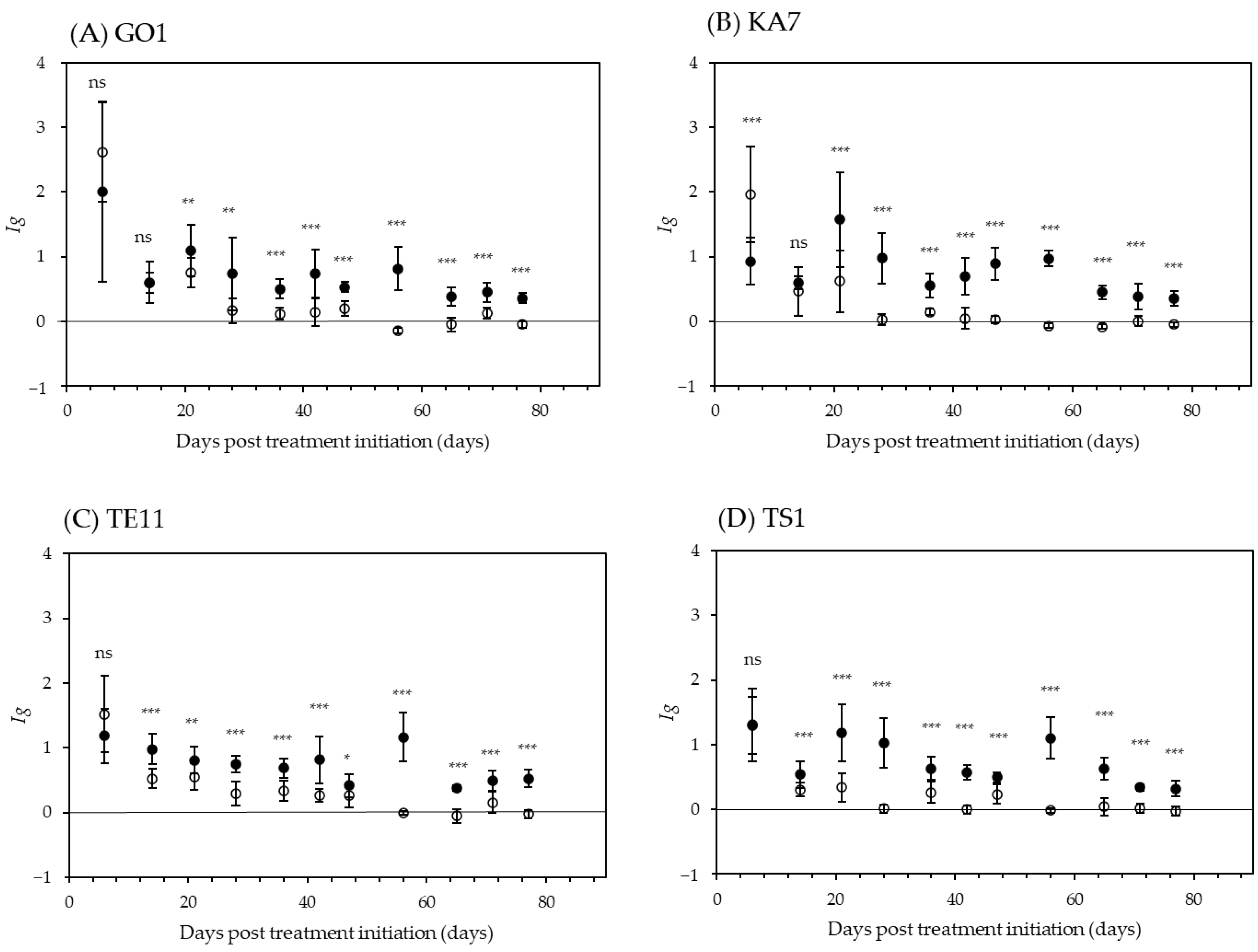

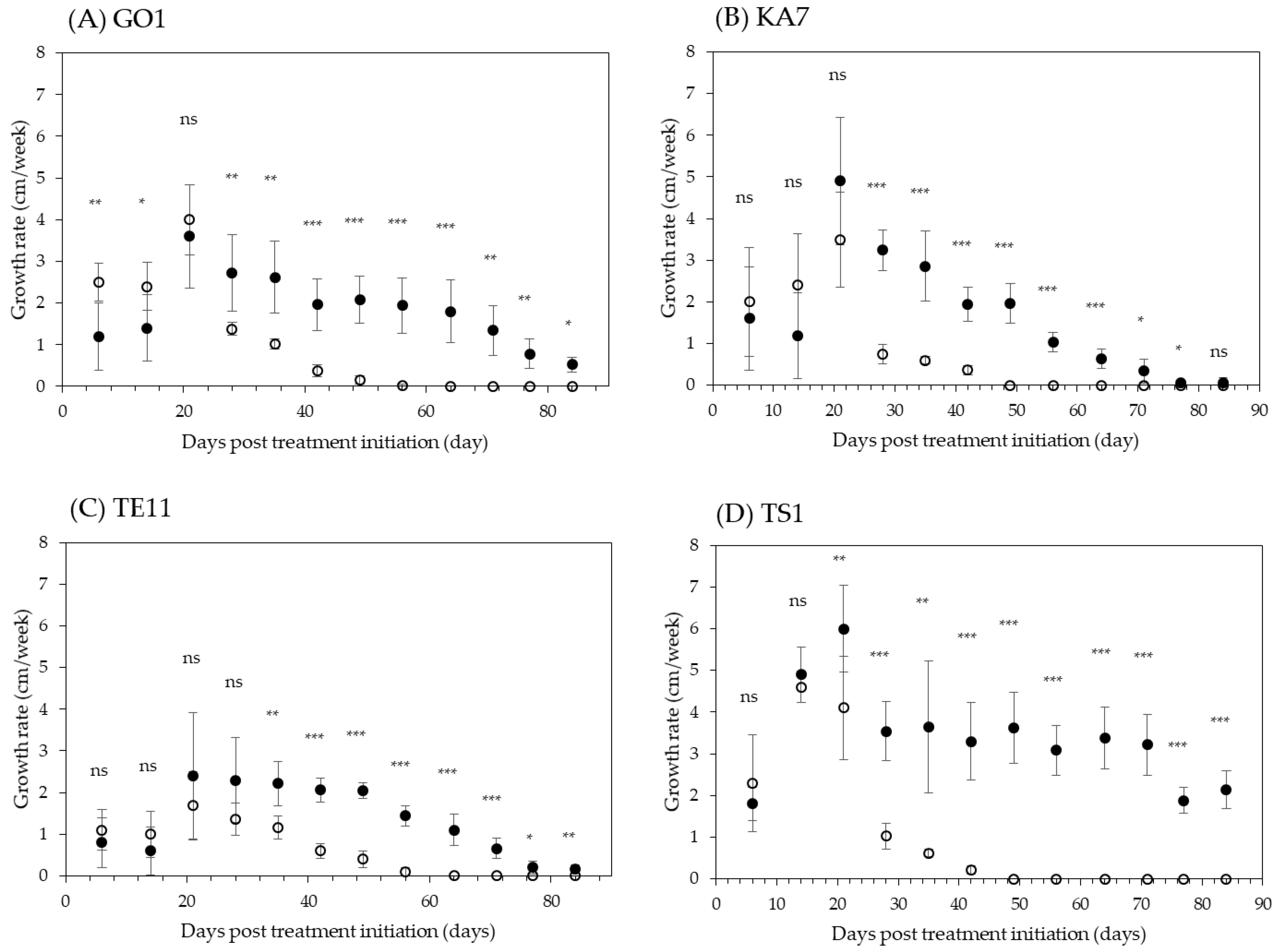
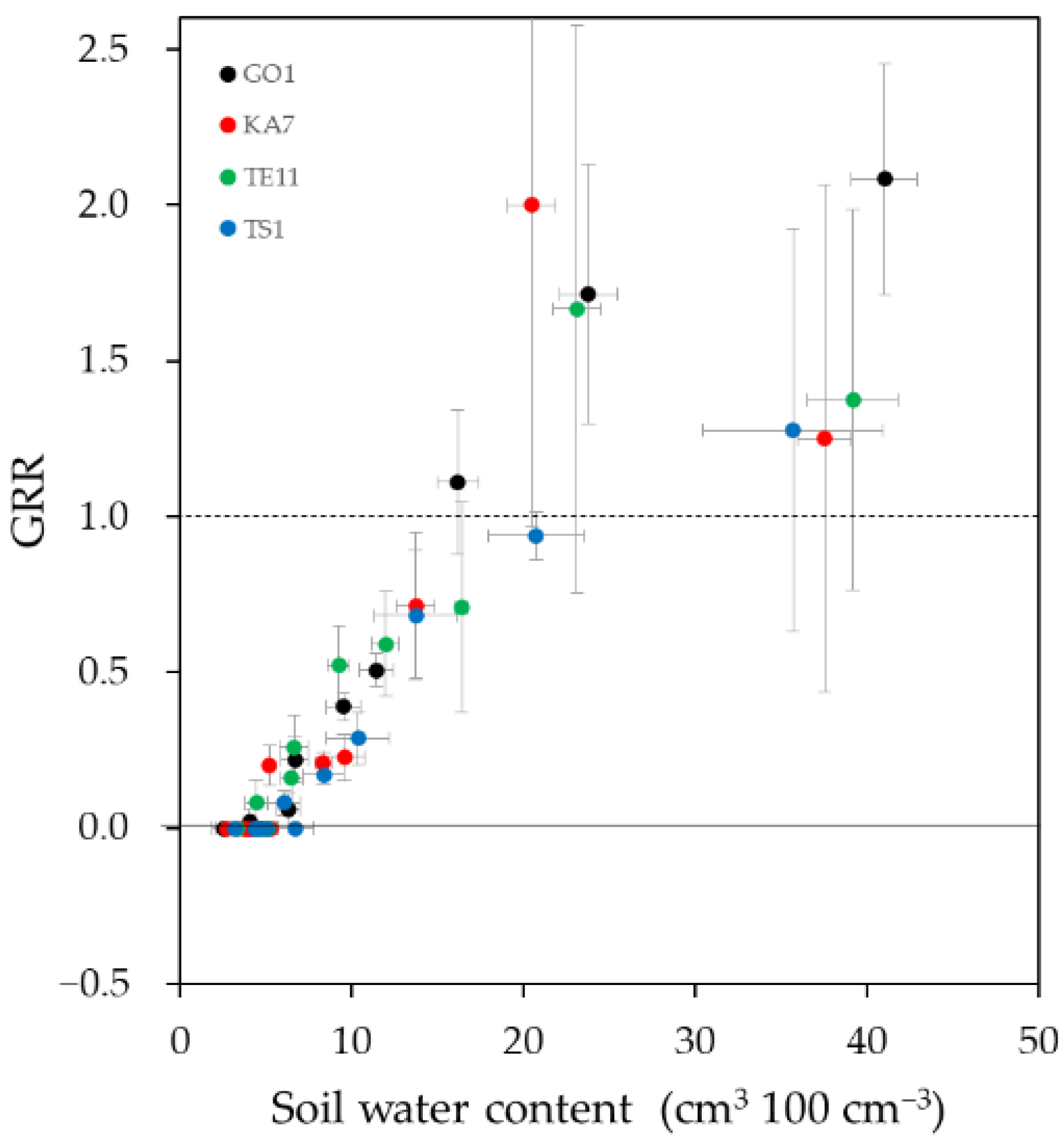
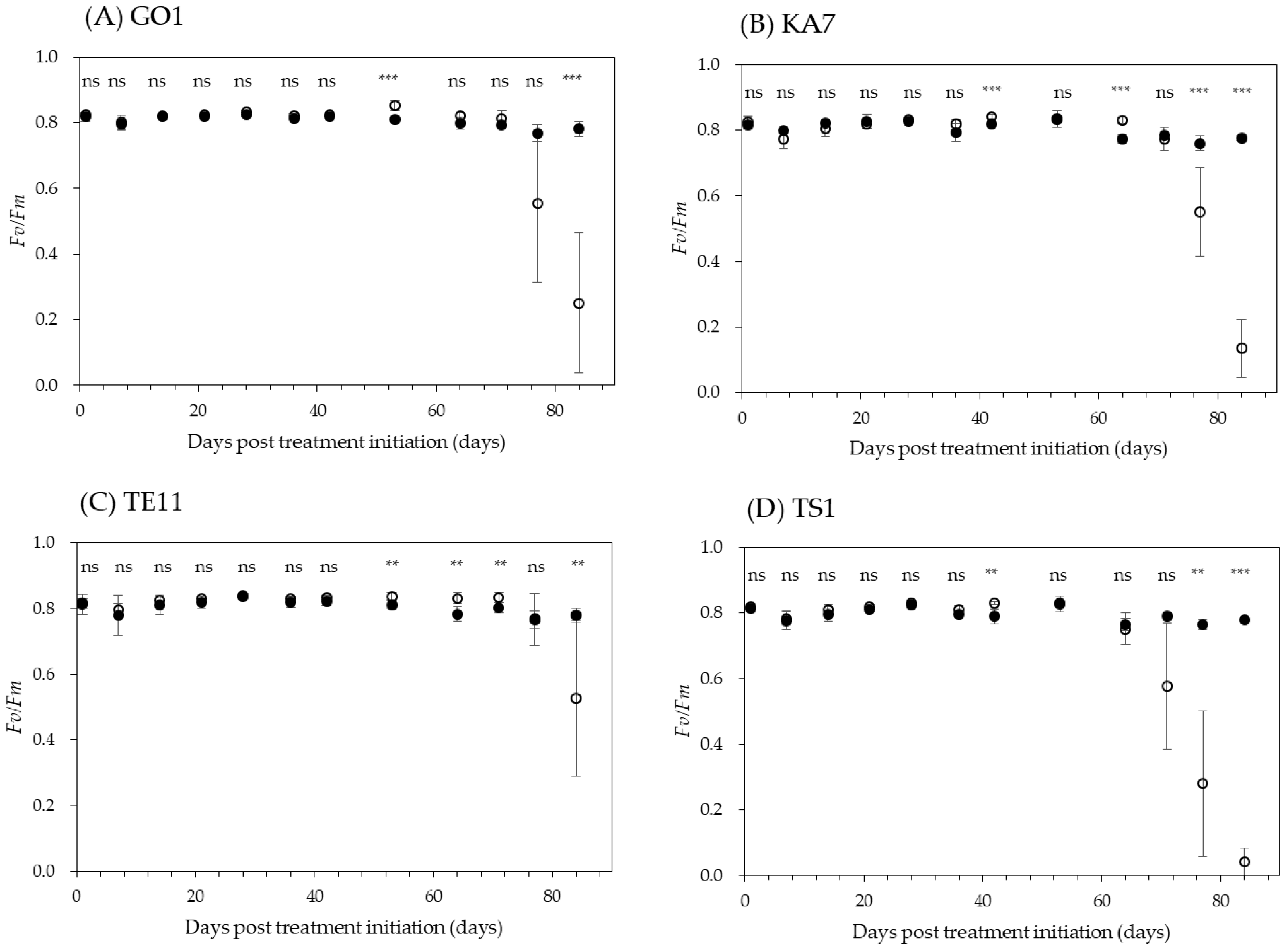
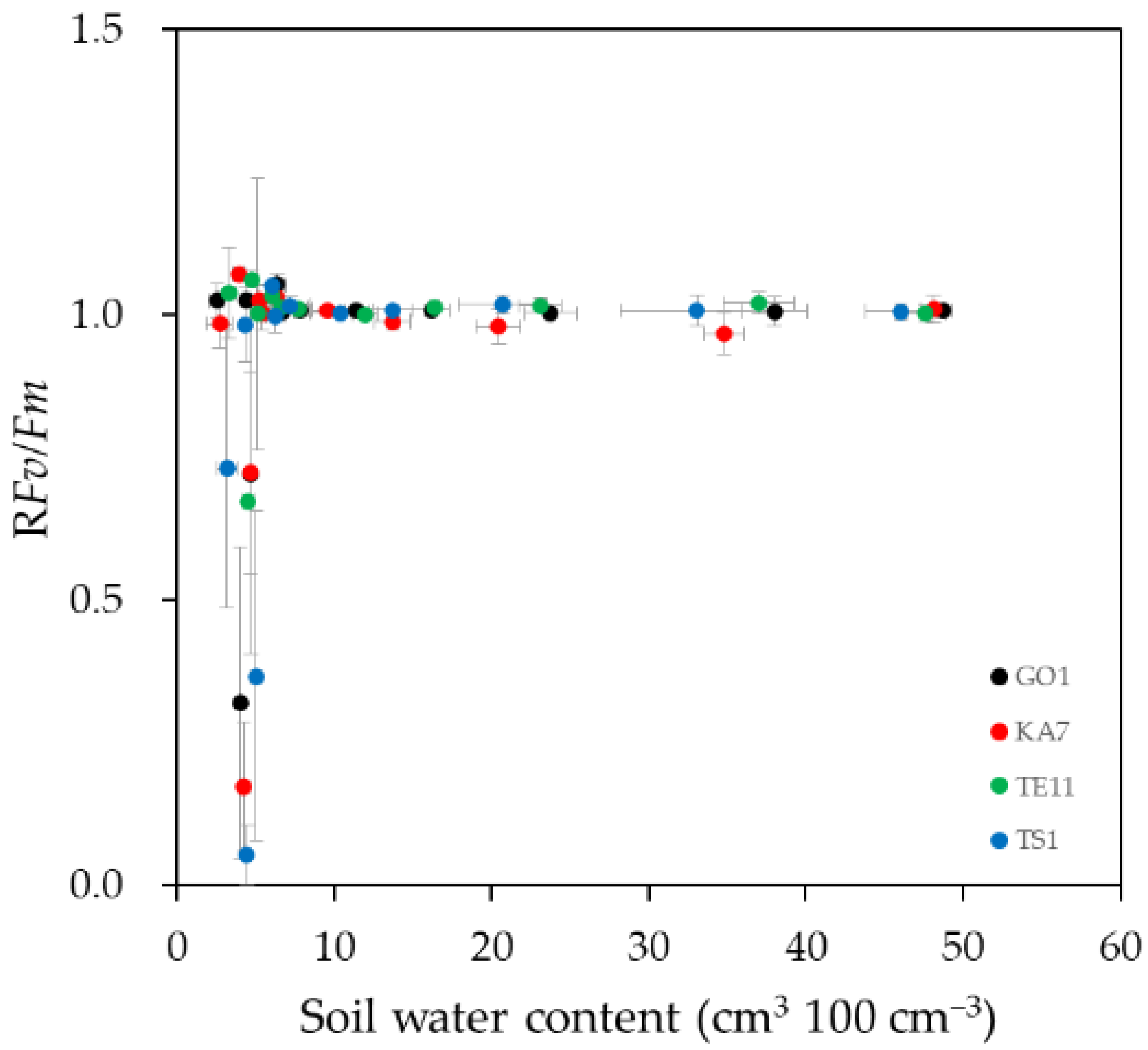
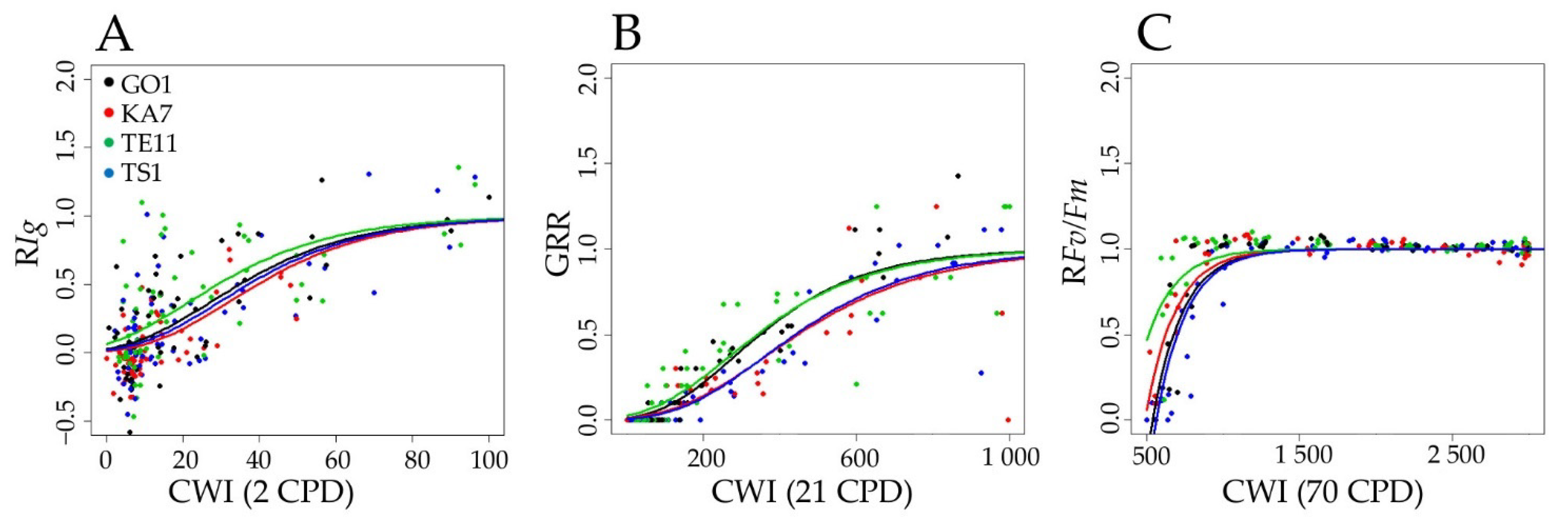
| Clone Name | Treatment | n | Height (cm) | SD |
|---|---|---|---|---|
| GO1 | Control | 5 | 38.5 | 5.0 |
| Drought | 5 | 37.7 | 5.9 | |
| KA7 | Control | 5 | 42.9 | 9.9 |
| Drought | 5 | 44.5 | 3.7 | |
| TE11 | Control | 5 | 39.2 | 3.6 |
| Drought | 5 | 34.8 | 4.4 | |
| TS1 | Control | 5 | 50.3 | 5.1 |
| Drought | 5 | 48.9 | 3.6 |
| Traits | p | Model Expression | Fixed Effects | SD of Random Effects | AIC | |||
|---|---|---|---|---|---|---|---|---|
| α | β | α | β | Residual | ||||
| RIg | 1 | CWIdp = k yij = exp(−α × exp(−β × CWIij)) + eij | 3.839 | 4.771 | 0.804 | 0.004 | 0.276 | 74.346 |
| 2 | 3.758 | 4.719 | 0.778 | 0.021 | 0.273 | 70.747 | ||
| 3 | 3.546 | 4.439 | 0.761 | 0.000 | 0.273 | 70.997 | ||
| 4 | 3.396 | 4.326 | 0.745 | 0.000 | 0.274 | 71.748 | ||
| 5 | 3.306 | 4.198 | 0.721 | 0.010 | 0.274 | 72.307 | ||
| 6 | 3.263 | 4.082 | 0.716 | 0.006 | 0.275 | 72.954 | ||
| 7 | 3.424 | 3.896 | 0.728 | 0.001 | 0.275 | 73.606 | ||
| 10 | 3.285 | 3.558 | 0.736 | 0.016 | 0.276 | 75.027 | ||
| 14 | 3.300 | 3.180 | 0.785 | 0.002 | 0.276 | 75.658 | ||
| 21 | 3.464 | 2.758 | 0.914 | 0.002 | 0.277 | 77.202 | ||
| 28 | 3.725 | 2.536 | 1.072 | 0.029 | 0.280 | 82.932 | ||
| 35 | 4.084 | 2.462 | 1.163 | 0.000 | 0.280 | 84.219 | ||
| 42 | 4.536 | 2.476 | 1.305 | 0.063 | 0.280 | 83.060 | ||
| 49 | 5.533 | 2.619 | 1.537 | 0.003 | 0.279 | 81.112 | ||
| 56 | 7.396 | 2.898 | 2.031 | 0.141 | 0.278 | 80.770 | ||
| 63 | 8.739 | 3.067 | 0.290 | 0.393 | 0.279 | 81.607 | ||
| 70 | 11.031 | 3.302 | 0.286 | 0.388 | 0.279 | 81.484 | ||
| 77 | 11.996 | 3.386 | 0.284 | 0.386 | 0.279 | 81.442 | ||
| 84 | 12.319 | 3.413 | 0.284 | 0.386 | 0.279 | 81.429 | ||
| GRR | 1 | CWIdp = k yij = exp(−α × exp(−β × CWIij)) + eij | 7.578 | 9.995 | 1.177 | 0.000 | 0.155 | −181.317 |
| 2 | 7.276 | 9.731 | 1.242 | 0.001 | 0.153 | −186.424 | ||
| 3 | 6.974 | 9.453 | 1.257 | 0.004 | 0.151 | −189.880 | ||
| 4 | 6.759 | 9.324 | 1.252 | 0.016 | 0.151 | −190.601 | ||
| 5 | 6.538 | 9.290 | 1.156 | 0.000 | 0.151 | −191.492 | ||
| 6 | 6.051 | 9.031 | 1.029 | 0.000 | 0.151 | −191.246 | ||
| 7 | 5.566 | 8.404 | 0.976 | 0.006 | 0.151 | −192.244 | ||
| 10 | 5.316 | 7.655 | 0.911 | 0.119 | 0.149 | −197.066 | ||
| 14 | 4.667 | 6.284 | 0.750 | 0.379 | 0.148 | −200.229 | ||
| 21 | 4.412 | 4.738 | 0.625 | 0.549 | 0.146 | −203.677 | ||
| 28 | 4.626 | 3.954 | 0.003 | 0.556 | 0.149 | −193.514 | ||
| 35 | 6.224 | 3.908 | 0.003 | 0.471 | 0.151 | −187.846 | ||
| 42 | 11.424 | 4.452 | 0.118 | 0.427 | 0.153 | −184.530 | ||
| 49 | 23.552 | 5.181 | 0.140 | 0.408 | 0.153 | −184.231 | ||
| 56 | 46.862 | 5.873 | 0.144 | 0.392 | 0.152 | −184.386 | ||
| 63 | 92.042 | 6.550 | 0.145 | 0.381 | 0.152 | −184.564 | ||
| 70 | 167.363 | 7.150 | 0.157 | 0.373 | 0.152 | −184.683 | ||
| 77 | 255.696 | 7.575 | 0.156 | 0.368 | 0.152 | −184.752 | ||
| 84 | 323.788 | 7.811 | 0.156 | 0.366 | 0.152 | −184.786 | ||
| RFv/Fm | 1 | CWIdp = k yij = 1 − exp(−β × (CWIij − α)) + eij | - | |||||
| 2 | - | |||||||
| 3 | - | |||||||
| 4 | - | |||||||
| 5 | - | |||||||
| 6 | −0.040 | 22.590 | 0.035 | 0.215 | 0.213 | −42.095 | ||
| 7 | −0.028 | 27.666 | 0.025 | 0.209 | 0.209 | −50.825 | ||
| 10 | −0.024 | 32.737 | 0.026 | 0.201 | 0.203 | −63.955 | ||
| 14 | 0.000 | 57.847 | 0.012 | 0.172 | 0.172 | −141.472 | ||
| 21 | 0.003 | 69.171 | 0.009 | 0.138 | 0.138 | −245.302 | ||
| 28 | 0.002 | 63.303 | 0.009 | 0.135 | 0.135 | −255.212 | ||
| 35 | 0.002 | 53.494 | 0.010 | 0.129 | 0.129 | −278.650 | ||
| 42 | 0.001 | 43.527 | 0.011 | 0.124 | 0.124 | −296.940 | ||
| 49 | −0.001 | 32.963 | 0.014 | 0.119 | 0.119 | −314.384 | ||
| 56 | −0.002 | 25.681 | 0.016 | 0.117 | 0.117 | −326.460 | ||
| 63 | −0.002 | 18.286 | 0.021 | 0.111 | 0.114 | −339.369 | ||
| 70 | −0.004 | 12.711 | 0.032 | 0.109 | 0.111 | −348.159 | ||
| 77 | −0.002 | 9.774 | 0.039 | 0.116 | 0.115 | −332.181 | ||
| 84 | 0.002 | 8.631 | 0.055 | 0.127 | 0.120 | −310.388 | ||
| Traits | CPD | Estimates of Random Effects in α | Estimates of Random Effects in β | Variance of Random Effects | ||||||||
|---|---|---|---|---|---|---|---|---|---|---|---|---|
| GO1 | KA7 | TE11 | TS1 | GO1 | KA7 | TE11 | TS1 | α | β | Residual | ||
| RIg | 2 | −0.1624 | 0.7303 | −1.0108 | 0.2428 | 0.0006 | −0.0004 | 0.0001 | −0.0004 | 0.6047 (88.9%) * | 0.0005 (0.1%) | 0.0748 |
| GRR | 21 | −0.0311 | 0.0976 | −0.7285 | 0.5117 | 0.5522 | −0.5550 | 0.1700 | −0.2895 | 0.3906 (2.1%) ** | 0.3012 (3.0%) ** | 0.0212 |
| RFv/Fm | 70 | 0.0196 | −0.0008 | −0.0455 | 0.0292 | 0.0198 | 0.0197 | 0.0136 | −0.0532 | 0.0010 (4.1%) ** | 0.0119 (46.9%) ** | 0.0124 |
Publisher’s Note: MDPI stays neutral with regard to jurisdictional claims in published maps and institutional affiliations. |
© 2021 by the authors. Licensee MDPI, Basel, Switzerland. This article is an open access article distributed under the terms and conditions of the Creative Commons Attribution (CC BY) license (http://creativecommons.org/licenses/by/4.0/).
Share and Cite
Takashima, Y.; Hiraoka, Y.; Matsushita, M.; Takahashi, M. Evaluation of Responsivity to Drought Stress Using Infrared Thermography and Chlorophyll Fluorescence in Potted Clones of Cryptomeria japonica. Forests 2021, 12, 55. https://doi.org/10.3390/f12010055
Takashima Y, Hiraoka Y, Matsushita M, Takahashi M. Evaluation of Responsivity to Drought Stress Using Infrared Thermography and Chlorophyll Fluorescence in Potted Clones of Cryptomeria japonica. Forests. 2021; 12(1):55. https://doi.org/10.3390/f12010055
Chicago/Turabian StyleTakashima, Yuya, Yuichiro Hiraoka, Michinari Matsushita, and Makoto Takahashi. 2021. "Evaluation of Responsivity to Drought Stress Using Infrared Thermography and Chlorophyll Fluorescence in Potted Clones of Cryptomeria japonica" Forests 12, no. 1: 55. https://doi.org/10.3390/f12010055
APA StyleTakashima, Y., Hiraoka, Y., Matsushita, M., & Takahashi, M. (2021). Evaluation of Responsivity to Drought Stress Using Infrared Thermography and Chlorophyll Fluorescence in Potted Clones of Cryptomeria japonica. Forests, 12(1), 55. https://doi.org/10.3390/f12010055





